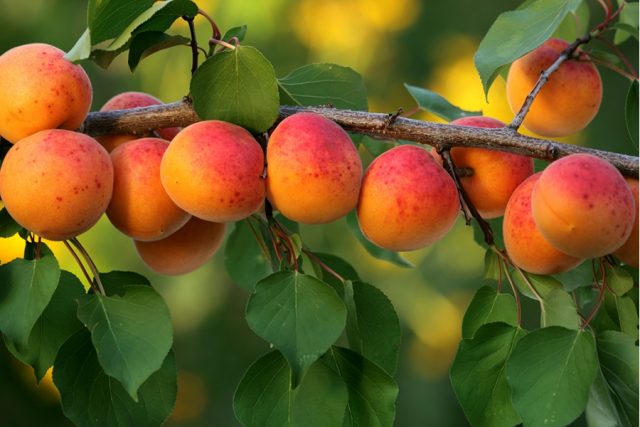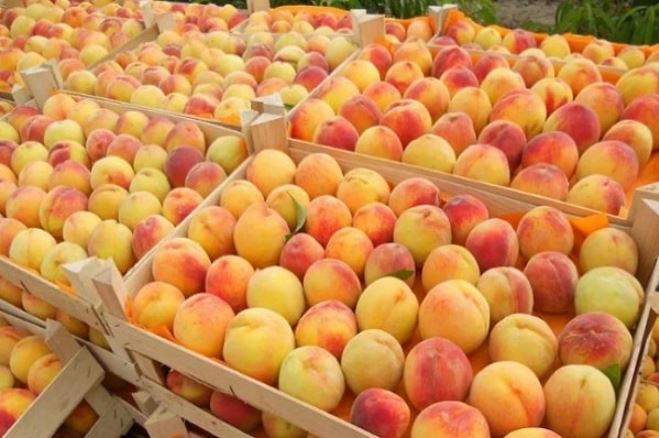Apricot Shalakh: a description of the Armenian variety, where it grows and when it ripens
Content:
Apricot Shalakh is a popular variety among gardeners. It was bred on the territory of Armenia. However, it gradually spread to other countries. People who decide to plant such an apricot on their plots should figure out in advance the peculiarities of its cultivation and caring for it.
Characteristics of the tree
Before planting, you must familiarize yourself with the description of the Shalah apricot. The tree can be considered medium-sized, since its height is no more than 2 m. The growth rate is moderate. Annual growth is about 25-35 cm in height.
The crown of the tree is not very dense, but at the same time it is round and wide. It is thanks to this that the crown dilution does not have to be done too often. Apricot branches are most often curved. They are quite thick and large. The branches are covered with large green, heart-shaped foliage.
At the end of May and in the first half of June, small flowers appear on the trees. Their diameter reaches 3 cm. They do not bloom for long - only 1-2 weeks.
Description of fruits
Towards the middle of summer, the first fruits begin to appear on the branches of the Armenian variety. After ripening, they become quite large. One mature apricot can weigh about 100-120 g. Their shape is ovoid, less often oval apricots are found. The abdominal suture is clearly visible on the surface of the fruit. The skin is smooth, with slight tubercles. The color of the surface of ripe fruits may vary. Most often, there are orange apricots with a slight reddish tint.
Disadvantages and advantages
Gardeners who are going to plant Shalakh on their plots should know its advantages and disadvantages. Among the main advantages of the variety are the following:
- Productivity. With proper care, each planted tree can ripen 80-100 kg of fruits.
- Frost resistance. This variety is not afraid of frost, so in winter it feels great outdoors both in the Middle Lane and in the North.
- Disease resistance. Shalakh almost never suffers from fungal diseases.
The disadvantages of the variety include:
- The yield depends a lot on the weather.
- Fall of overripe apricots.
- Slow maturation.
Choosing a place for planting
Before you start planting, you need to choose a suitable growing area. The gentle slopes are considered ideal for apricot and other stone fruit crops. The location chosen for growing trees should not be too windy. Strong gusts of wind can break branches or knock off fruit.
The soil must be fertile and contain a sufficient amount of nutrients. For apricot, areas with sandy-loamy soil are suitable.
How to plant an apricot: seed planting
Most often, gardeners grow apricot trees from planted seeds.
The planting process consists of several stages:
- Planting seeds. They must be planted in a small pot filled with a soil mixture of soil and peat. After 3-4 months, a seedling will grow from the seed, which can be transplanted into open ground.
- Preparation of the landing pit. It is necessary to prepare a hole in which the bone will be planted 15 days before planting on the site. Its depth should be 50-60 cm, and its width should be 40-50 cm. The bottom of the pit should be covered with a small amount of rubble, which will act as drainage.
- Soil preparation. In order for the apricot to start growing well immediately, it must be planted in a properly prepared soil mixture. To do this, mix 2 parts of the earth with 1 part of peat. You can also add some phosphorus and nitrogen fertilizers.
- Landing. When the pit and soil mixture are prepared, you can start planting. The soil needs to be slightly moistened with warm water, after which sprouted apricot seedlings can be planted in it.
Care features
Shalah pineapple apricot will grow well only if it is properly cared for.
Pruning
For apricot trees to bear fruit better, you will have to regularly prune them. This procedure should be carried out annually in autumn or spring. You need to cut off already dried branches and stems on which fruits do not form.
Crown formation
During crown formation, the plant is pruned at a height of one meter. It is necessary to leave two branches that are directed along the tree. The rest are cut into a ring. The central stem is not cut off, it should be 20-30 cm higher than other branches.
Watering
In the first 30-40 days after planting, the tree should be watered at least twice a week. In this case, you must use water warmed up to room temperature. A bucket of water is consumed for each tree.
Whitewash
Whitewashing of grown trees is an agricultural technique that is used to protect the crown of plants from frost and sunburn. It is necessary to whitewash apricot trees in late spring, in the second half of May.
Top dressing
Top dressing is applied depending on the condition of the soil. If there are not enough nutrients in it, wilting of the branches can occur. The first feeding is carried out in the middle of spring. During this period, nitrogen fertilizers are added to the soil. In summer and autumn, the apricot is fed with phosphorus and potash mixtures.
Ripening and harvesting
Shalah is recommended to be harvested in the first half of August, after the fruits are fully ripe. In this case, cleaning is best done with special gloves so as not to accidentally damage the fleecy cover. The collected fruits should be put in several layers in plastic or wooden boxes.
Harvest storage
The harvested crop is recommended to be stored in a room where the temperature does not rise above ten degrees Celsius. The cellar can be considered an ideal place for long-term storage of apricots. Some people keep them in the refrigerator. However, in this case, the harvested apricots will have to be transferred to food containers or other sealed packages.
Pests and diseases
Some believe that only pollinating insects fly around the apricot. However, in fact, pests can also attack trees. These include:
- aphids;
- leaf rollers;
- weevils;
- silkworms.
Also, trees can get sick with powdery mildew, cytosporosis, moniliosis and verticillosis. To combat them, special drugs are used.
The Shalakh variety is popular among apricot lovers. Gardeners who want to grow it on their site and get a good harvest should become familiar with the peculiarities of planting this variety and how to care for it.





















